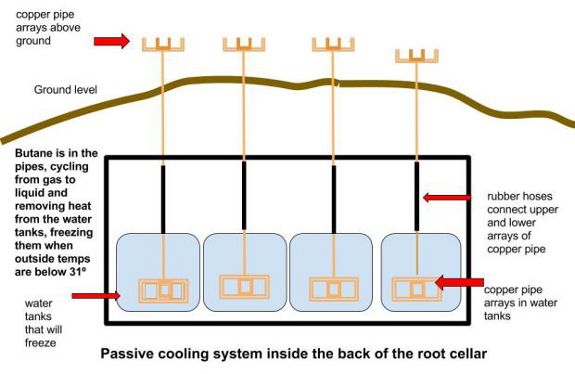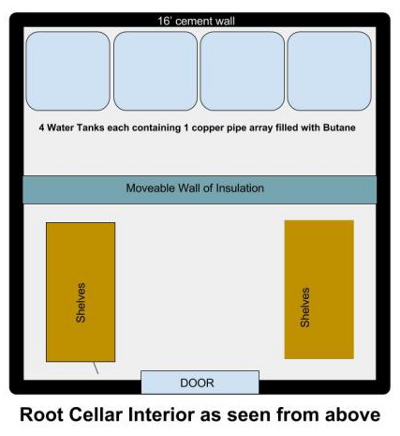
A root cellar that stays cold in the summer

One of our readers
dropped me an email Monday to tell me about the root cellar she and her
husband want to build on their Vermont farm. The couple plan to give the
off-grid  cooler
extra oomph in the summer months by storing ice in the back, using
copper pipes full of butane to passively stockpile winter cold for
warm-weather use.
cooler
extra oomph in the summer months by storing ice in the back, using
copper pipes full of butane to passively stockpile winter cold for
warm-weather use.
In essence, they're hoping to combine the idea of an ice house with the
idea of a root cellar. If it works, they'll have achieved an
electricity-free, four-season temperature-modified area, allowing the
couple to feed themselves and their CSA customers all year
long...without the hard work of chipping blocks of ice out of the pond
every winter.
Will the ice-house/root-cellar combo go the distance? Donate to their Indiegogo campaign at the $15 level and
you'll get two years of temperature records in digital format to answer
that question. In the meantime, I'd be curious to hear your thoughts on
this innovative root cellar that's different from any I've ever seen
before.
Want more in-depth information? Browse through our books.
Or explore more posts by date or by subject.
About us: Anna Hess and Mark Hamilton spent over a decade living self-sufficiently in the mountains of Virginia before moving north to start over from scratch in the foothills of Ohio. They've experimented with permaculture, no-till gardening, trailersteading, home-based microbusinesses and much more, writing about their adventures in both blogs and books.
Want to be notified when new comments are posted on this page? Click on the RSS button after you add a comment to subscribe to the comment feed, or simply check the box beside "email replies to me" while writing your comment.

Interesting concept. Seems to be a reverse of a solar hot water heater.
Here in East TN, there's a local city grammar school whose heating/cooling system is geothermal. Apparently they sunk pipes down into the ground (not sure how many feet but I think it was 10) where the ground is a constant 45-50 degrees and they linked that into the heat pump to keep the temperature in the classrooms at a constant temperature. This is not a one-room schoolhouse, but a large elementary school. So I guess these folks' idea is not to far distant from that.
Hi All,
Is this idea working somewhere else in this form?
Or is this original research?
If it is original research, a small pilot version would seem like a better idea. And far removed from human occupied buildings. Who knows what unforseen corrosion, flamability or toxic vapor problems may arise as time goes on?
i.e.- Does the human entering the enclosure die from butane fumes when the rubber hoses leak or from lack of oxygen with the butane displacing the room's oxygen ?
Or is it just: "Damn the torpedoes, full speed ahead"? And hope and pray?
John
This is called a “heat pipe”. It is a very efficient way of moving heat from a hot place to a cold place because evaporation and condensation typically uses and releases much more energy per unit of mass than just heating up a liquid or a vapour. It is also kind of a one-way heat conductor. The bottom of the pipe is filled with a liquid where it can evaporate, while the top half is filled with vapour which can condense. The thing is; it needs to be hot enough in the root cellar to evaporate the working fluid, absorbing heat in the process. The vapour drifts upward to the other end of the heat pipe which needs to be cool enough for the vapour to condensate and the liquid to run back down.
So the temperature difference between the two ends of the heat pipe is the “motor” that keeps it working. If the temperature difference is too small the heat pipe stops working. You'd have to keep the copper pipes aboveground out of the sunlight for one thing.
Note that as opposed to a refrigerator, the whole system works at a constant pressure. The copper pipes should be OK but I wonder if rubber hose would contain the butane in the long run. Filling the system also needs to be done carefully since you're working with flammable liquids and vapours. I would maybe look into other working fluids such as acetone. This is also flammable but not as much. And a leak would be easily spotted because of the smell.
As Roland said above, this is called a "heat pipe", and as he said, it's "one way". This is where the plan to use the heat pipes in the summer falls down.
Heat pipes work via convection, liquid warms at the bottom of the pipe and travels upwards, radiating heat as it goes. When it reaches the top, it is now cooler than the fluid at the bottom of the pipe, and it begins to sink. A continuous convective current sets up.
This only works though if the environment at the top of the pipe is cooler than the environment at the bottom, otherwise the liquid will gain energy as it climbs. That will result in a stagnant temperature gradient, cold at the bottom, warm at the top, and no continuous flow can set up. Convection can't operate in opposition to gravity except in really unusual circumstances (it doesn't occur at all on the space station, for example), so it can't even act to effectively transport heat down the pipe in to the water, though it will still do so through conduction...slowly.
In short, this system will result in heat being transported very slowly from the outside to the inside whenever the outside temperature is higher than the root cellar temperature (most of the time in the summer, obviously), not the other way around.
Now, if they could set one end of the heat pipes in to a moving water source or some sort of system that used atmospheric evaporation to cool the heat pipes to below ambient, they might pull it off year round. Even better, ground water temperature is rarely more than about 5 degrees higher than average annual temperature, which means that in New England, it's generally between 50 and 55F. It would be a challenge, but not impossible, to utilize running surface water to move ground water across a heat exchanger to cool the root cellar year round.
Seeing as good ol' fashioned root cellars have been serving us well for centuries, what real advantage does this elaborate innovation actually accrue? Secondly, Crowd Funding? You could set it up for about $200- using new materials- and less if you repurpose old stuff.(There's a smell here, and it ain't butane.) Third- the "movable insulating wall" would defeat the purpose.
It's also doubtful that the passive liquid/gas cycling would work as depicted because the sun heating the exposed pipes would keep the butane in the gas state above ground. Those pipes would attain temps well above 180*F during a sunny day. An insulated return pipe might do the trick creating a siphon effect.
Thanks for all the feedback, commenters. I am one of the farmers at Peace of Earth Farm where we are proposing the trial of this passive cooler. I'll try to address as many of your concerns as possible, though a conversation would be a lot easier. There has been a similar pilot project done by our friend who is helping us with the design. His project was not in a root cellar, but instead a tank of water was insulated above ground and the same system of pipe filled with butane was used inside the tank and reaching outside to the winter air to freeze the tank of water. He then had a fan blowing the cold air from the ice filled tank into a cooler inside his house. He was able to maintain ice in the tank until late July. I think we can improve on those conditions to hold onto the ice for much longer. The diagram included in our project is pretty simple and does not include some intended additions such as pressure regulators on the pipes, and some sort of a-frame to keep sun off of the pipes in summer. The rubber hose interrupting the pipes is intended to stop heat from transferring down the pipe into the water tank, but I am sure some heat will still transfer and yes, the ice will slowly melt in the summer months. We didn't think that we would be making ice in the summer, just holding onto it as long as possible. Root cellars are good at staying in the 50s during summer months- we are just trying to see if we can take that down 10 degrees or so to be in the refrigerated zone. The scale of the project is matching the size we think we need for storage on our farm. A similar project could be done in many ways and scales appropriate for the home/farm owner. Most of the expense of the project is going into the root cellar construction, the tanks and copper piping are actually a small part of the total cost. Butane has been chosen because of its unique property of boiling at 31degrees, making it easy to evaporate by water that is starting out in the 40s, and easy to condense in average winter temperatures in VT, driving that heat pipe motor that was mentioned above. As for any potential leakage and corrosion, that is something we will have to pay close attention to preventing.
So what you're basically building is an ice-house, using the heat-pipe as a heat-pump to cool down a cold reservoir.
As long as you have winters that are cold enough to make the water tanks freeze over, the heat-pipe concept should work OK. Depending on the degree of insulation you will need to reserve more or less space for ice storage.
Another approach could be to use the guts of a 12V refigerator. Mount the evaporator panels inside your root-cellar, and the condensor outside. Use a couple of solar panels to drive the compressor. This has the advantage of doing actual cooling work when it's most needed (in the summer).
If you want to avoid pumps at all cost look at the absorption refrigeration cycle. This can be driven by an external heat source (thermal solar panel!) and has no moving parts. It is more complex to make, though. But it also works best in the summer.